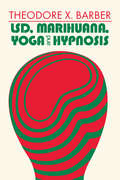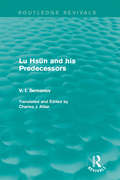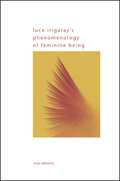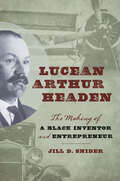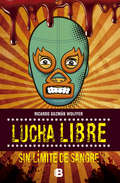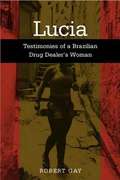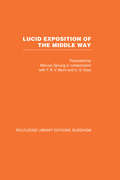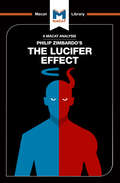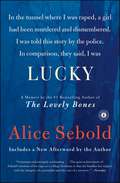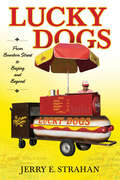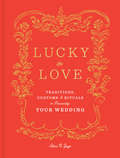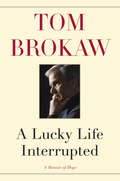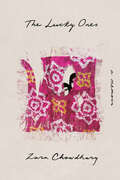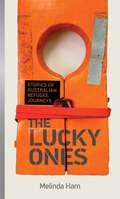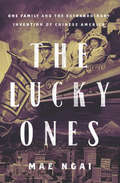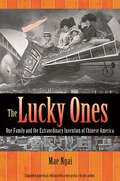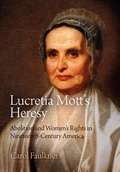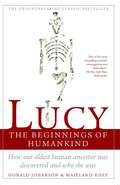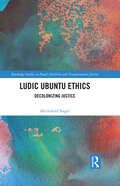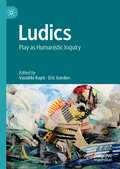- Table View
- List View
LSD, Marihuana, Yoga, and Hypnosis
by Theodore X. BarberThe practice of yoga, hypnosis, and the use of psychedelic drugs to alter psychological and physiological states is not unknown to the study of psychology. They have been called "soft" studies and labeled unimportant. This is mostly because they are difficult to study and understand, often focusing on unobservable internal states such as altered states of consciousness, Samadhi, or hypnotic states. This book, in its approach to thinking about this topic and method for analysis, focuses only on phenomena that can be observed, such as behavioral changes.By centering on only those aspects of the psychological and physiological effects of yoga, hypnosis, and psychedelic drugs which can be measured and analyzed using this new method, Barber distinguishes this book from others in the field. He asks what overt behaviors and verbal reports are clearly observable when psychedelic drugs are taken, yoga is practiced, or hypnotic-induction procedures are administered. Instead of treating the phenomena traditionally associated with psychedelic drugs, yoga, or hypnosis as undifferentiated conglomerates, an attempt will be made to set apart and treat separately each of the many phenomena associated with each of these areas of inquiry.This book does not set out to simply demonstrate the importance of psychedelics, yoga, and hypnosis, or to present substantive material pertaining to these topics. It also treats each topic as continuous with other known psychological phenomena and as an important piece to the puzzle of social psychology. It differs from most previous treatises in that it does not assume that psychedelics, yoga, and hypnosis can bring out unused mental or physical capacities in man, heighten awareness or give rise to enhanced creativity, or produce altered states of consciousness, suspension of conventional reality-orientation, changes in body-image, or changes in perception.
Lu Hsün and his Predecessors (Routledge Revivals)
by V. I. SemanovOriginally published in 1980, Alber’s translation of Semanov’s study aimed to contribute to the studies of Chinese literature and the knowledge of Lu Hsün’s work to an English-speaking reader. Lu Hsün was an influential democrat and humanist in early twentieth Century China and his work had a great influence on literature in China. Semanov therefore attempted to place his life and work in the context of his literary predecessors as well as commenting on his world view, his teaching and place in history. This title will be of interest to students of Asian studies and Literature.
The Lubicon Lake Nation
by Dawn Martin-HillMany argue that the Lubicon, a small Cree nation in northern Alberta, have been denied their unalienable right to self-determination by the Canadian government. In a country such as Canada, some see the plight of the Lubicon people as an enduring reminder that certain democratic principles and basic freedoms are still kept from minorities, indigenous groups in particular.The Lubicon Lake Nation strives, through a critique of historically-constructed colonial images, to analyze the Canadian government's actions vis-à-vis the rights of the Lubicon people. Dawn Martin-Hill illustrates the power of indigenous knowledge by contrasting the words, ideas, and self-conceptualizations of the Lubicon with official versions of Lubicon history as documented by the state. In doing so, she offers a genuine sense of the gravity of their lived experiences. By giving voice to the Lubicon, this study seeks to develop an exclusively indigenist framework in which the circumstances facing the people can be described and analyzed more accurately than they can using popular conceptions of native rights as put forth by the government.The Lubicon Lake Nation is a story of one culture and the pursuit of indigenous rights in Canada as told from the perspective of those who know the situation best, the Lubicon themselves.
Luce Irigaray's Phenomenology of Feminine Being (SUNY series in Gender Theory)
by Virpi LehtinenThe reception of Luce Irigaray's ideas about feminine identity has centered largely on questions of essentialism, whether criticizing this as a destructive flaw or interpreting it in strategic or pragmatic terms. Staking out an alternative approach, Virpi Lehtinen finds in the phenomenology of Husserl and Merleau-Ponty a framework for what she characterizes as dynamic essentialism, which seeks to account for the complex networks of lived experience: embodied, affective, and spiritual relations to oneself, to others, and to the world. Rather than prescribing one norm to which all women should conform, Lehtinen argues, Irigaray's work exemplifies how each individual woman in her own way contributes to a norm of femininity that is both unique and singular but also connected to the existential styles of past, present, and future others.
Lucean Arthur Headen: The Making of a Black Inventor and Entrepreneur
by Jill D. SniderBorn in Carthage, North Carolina, Lucean Arthur Headen (1879–1957) grew up amid former slave artisans. Inspired by his grandfather, a wheelwright, and great-uncle, a toolmaker, he dreamed as a child of becoming an inventor. His ambitions suffered the menace of Jim Crow and the reality of a new inventive landscape in which investment was shifting from lone inventors to the new "industrial scientists." But determined and ambitious, Headen left the South, and after toiling for a decade as a Pullman porter, risked everything to pursue his dream. He eventually earned eleven patents, most for innovative engine designs and anti-icing methods for aircraft. An equally capable entrepreneur and sportsman, Headen learned to fly in 1911, manufactured his own "Pace Setter" and "Headen Special" cars in the early 1920s, and founded the first national black auto racing association in 1924, all establishing him as an important authority on transportation technologies among African Americans. Emigrating to England in 1931, Headen also proved a successful manufacturer, operating engineering firms in Surrey that distributed his motor and other products worldwide for twenty-five years.Though Headen left few personal records, Jill D. Snider recreates the life of this extraordinary man through historical detective work in newspapers, business and trade publications, genealogical databases, and scholarly works. Mapping the social networks his family built within the Presbyterian church and other organizations (networks on which Headen often relied), she also reveals the legacy of Carthage's, and the South's, black artisans. Their story shows us that, despite our worship of personal triumph, success is often a communal as well as an individual achievement.
Las luces del retorno
by Juan A. Soto-EscuderoValor. Confianza. Paciencia. El fenómeno de la inmigración encierra muchos tópicos sociales, económicos y jurídicos. Una de las principales características que ha tenido el ser humano ha sido su tendencia de moverse de un lugar a otro. <P><P> Actualmente debido a la complejidad de nuestra sociedad,y a los siempre presente problemas de búsqueda de oportunidades y conflictos regionales, la inmigración a crecido hasta convertirse en una situación global.
Lucha libre: Sin límite de sangre
by Ricardo Guzmán Wolffer¡Lucharán de dos a tres caídas, sin límite de sangre! Reflexión sociológica sobre este deporte-espectáculo visto desde una óptica multidisciplinaria. Cuando el ring se tiñe de rojo, la historia mexicana revive, nos toca de nuevo el inconsciente. Este deporte permite la individualidad del espectador en tiempos de impotencia. La lucha libre es cultura, deporte, show, sangre y desahogo. Puede crear mitos y derribar ídolos. Pero también es, sin duda, la eterna metáfora del bien contra el mal que todos llevamos dentro.
Lucia: Testimonies of a Brazilian Drug Dealer's Woman
by Robert Gay"Favelas, or shantytowns, are where cocaine is mainly sold in Rio de Janeiro. There are some six hundred "favelas in the city and most of them are controlled by well-organized and heavily armed drug gangs. The struggle for the massive profits from this drug trade has resulted in what are increasingly violent and deadly confrontations between rival drug gangs and a corrupt and brutal police force, that have transformed parts of the city into a war-zone. "Lucia tells the story of one woman who was once intimately involved with drug gang life in Rio throughout the 1990s. Through a series of conversations with the author, Lucia describes conditions of poverty, violence and injustice that are simply unimaginable to outsiders. In doing so, she explains why women like her become involved with drugs and gangs and why this situation is unlikely to change.
Lucid Exposition of the Middle Way: The Essential Chapters From The Prasannapada of Candrakirti (Routledge Library Editions: Buddhism)
by Mervyn SprungOriginally published in 1979. The Prasannapada is the explanation of the versed aphorisms of Nagarjuna which are the first and basic statement of the Buddhist philosophy of the middle way. When first published, this volume was the first attempt, in any European language, to present all the essentials of this most radical of Buddhist philosophical works. Seventeen of its twenty-seven chapters have been chosen to give an integrated statement of every aspect of its arguments and conclusions.
The Lucifer Effect
by Alexander O’ConnorWhat makes good people capable of committing bad – even evil – acts? Few psychologists are as well-qualified to answer that question as Philip Zimbardo, a psychology professor who was not only the author of the classic Stanford Prison Experiment – which asked two groups of students to assume the roles of prisoners and guards in a makeshift jail, to dramatic effect – but also an active participant in the trial of a US serviceman who took part in the violent abuse of Iraqi prisoners in the wake of the second Gulf War. Zimbardo’s book The Lucifer Effect is an extended analysis that aims to find solutions to the problem of how good people can commit evil acts. Zimbardo used his problem-solving skills to locate the solution to this question in an understanding of two conditions. Firstly, he writes, situational factors (circumstances and setting) must override dispositional ones, meaning that decent and well-meaning people can behave uncharacteristically when placed in unusual or stressful environments. Secondly, good and evil are not alternatives; they are interchangeable. Most people are capable of being both angels and devils, depending on the circumstances. In making this observation, Zimbardo also built on the work of Stanley Milgram, whose own psychological experiments had shown the impact that authority figures can have on determining the actions of their subordinates. Zimbardo's book is a fine example of the importance of asking productive questions that go beyond the theoretical to consider real-world events.
Lucky
by Alice SeboldEnormously visceral, emotionally gripping, and imbued with the belief that justice is possible even after the most horrific of crimes, Alice Sebold's compelling memoir of her rape at the age of eighteen is a story that takes hold of you and won't let go.Sebold fulfills a promise that she made to herself in the very tunnel where she was raped: someday she would write a book about her experience. With Lucky she delivers on that promise with mordant wit and an eye for life's absurdities, as she describes what she was like both as a young girl before the rape and how that rape changed but did not sink the woman she later became.It is Alice's indomitable spirit that we come to know in these pages. The same young woman who sets her sights on becoming an Ethel Merman-style diva one day (despite her braces, bad complexion, and extra weight) encounters what is still thought of today as the crime from which no woman can ever really recover. In an account that is at once heartrending and hilarious, we see Alice's spirit prevail as she struggles to have a normal college experience in the aftermath of this harrowing, life-changing event.No less gripping is the almost unbelievable role that coincidence plays in the unfolding of Sebold's narrative. Her case, placed in the inactive file, is miraculously opened again six months later when she sees her rapist on the street. This begins the long road to what dominates these pages: the struggle for triumph and understanding -- in the courtroom and outside in the world.Lucky is, quite simply, a real-life thriller. In its literary style and narrative tension we never lose sight of why this life story is worth reading. At the end we are left standing in the wake of devastating violence, and, like the writer, we have come to know what it means to survive.
Lucky
by Alice SeboldEnormously visceral, emotionally gripping, and imbued with the belief that justice is possible even after the most horrific of crimes, Alice Sebold's compelling memoir of her rape at the age of eighteen is a story that takes hold of you and won't let go. Sebold fulfills a promise that she made to herself in the very tunnel where she was raped: someday she would write a book about her experience. With Lucky she delivers on that promise with mordant wit and an eye for life's absurdities, as she describes what she was like both as a young girl before the rape and how that rape changed but did not sink the woman she later became. It is Alice's indomitable spirit that we come to know in these pages. The same young woman who sets her sights on becoming an Ethel Merman-style diva one day (despite her braces, bad complexion, and extra weight) encounters what is still thought of today as the crime from which no woman can ever really recover. In an account that is at once heartrending and hilarious, we see Alice's spirit prevail as she struggles to have a normal college experience in the aftermath of this harrowing, life-changing event. No less gripping is the almost unbelievable role that coincidence plays in the unfolding of Sebold's narrative. Her case, placed in the inactive file, is miraculously opened again six months later when she sees her rapist on the street. This begins the long road to what dominates these pages: the struggle for triumph and understanding -- in the courtroom and outside in the world. Lucky is, quite simply, a real-life thriller. In its literary style and narrative tension we never lose sight of why this life story is worth reading. At the end we are left standing in the wake of devastating violence, and, like the writer, we have come to know what it means to survive.
Lucky Child: A Daughter of Cambodia Reunites with the Sister She Left Behind (P. S. Ser.)
by Loung UngAfter enduring years of hunger, deprivation, and devastating loss at the hands of the Khmer Rouge, ten-year-old Loung Ung became the "lucky child," the sibling chosen to accompany her eldest brother to America while her one surviving sister and two brothers remained behind. In this poignant and elegiac memoir, Loung recalls her assimilation into an unfamiliar new culture while struggling to overcome dogged memories of violence and the deep scars of war. In alternating chapters, she gives voice to Chou, the beloved older sister whose life in war-torn Cambodia so easily could have been hers. Highlighting the harsh realities of chance and circumstance in times of war as well as in times of peace, Lucky Child is ultimately a testament to the resilience of the human spirit and to the salvaging strength of family bonds.
Lucky Dogs: From Bourbon Street to Beijing and Beyond
by Jerry E. StrahanWhen walking the French Quarter and watching a Lucky Dog salesman set up that colorful cart and call out to entice customers, don't you wonder how such a business works? As a knowing review in Rolling Stone stated, "People have always loved the cart and harbored a mysterious need to ride it. Revelers have been known to climb on top of the rolling wienies, screaming 'Yippee kaya!' as vendors stoically push them back to the barn at 4 a.m." Since 1947 the red and yellow carts have trumpeted good fortune and sustenance.Jerry E. Strahan recounts the wild adventures of the Bourbon Street wienie salesmen but also takes readers well beyond New Orleans. In fact, he takes them halfway around the world, where this unique pushcart business maneuvered its way through the bureaucratic red tape of a communist country to become a licensed corporation in the People's Republic of China.In China, two points quickly became apparent to Strahan. First, 99 percent of the Chinese population had no idea what a Lucky Dog cart represented. One elderly passerby declared it to be a missile. Second, the success or failure of any joint venture in the Asian nation is directly proportional to the political clout of that company's local partner.Lucky Dogs also recounts how the business and its vendors survived Hurricane Katrina. Miraculously, it reopened only six months after the storm in a city where more than 80 percent of the landmass had been flooded and where less than 40 percent of the population had returned. To reestablish itself in what many described as Third World conditions, the company had to transform its operation.This work mixes business history, autobiography, survival story, and an insider's look at the bizarre lives of some of Bourbon Street's most quirky characters--the dauntless Lucky Dog vendors. Both humorous and tragic, though it may read like fiction, it is, for better or worse, all fact.
Lucky in Love: Traditions, Customs, and Rituals to Personalize Your Wedding
by Eleni N. GageEvery engaged couple wants two things: a meaningful wedding and a lifetime of happiness. This great gift book is a cross-cultural collection of marriage folklore that will help you achieve both. Create your own lucky traditions with nods to each other’s heritage, customs from places you’ve visited together, and auspicious rituals that just feel special. Whether you are just engaged or you’re days away from tying the knot, you’ll gain insight every step of the way. With this book as your guide, you can make your own luck in love.
A Lucky Life Interrupted
by Tom BrokawFrom Tom Brokaw, the bestselling author of The Greatest Generation, comes a powerful memoir of a year of dramatic change--a year spent battling cancer and reflecting on a long, happy, and lucky life. Tom Brokaw has led a fortunate life, with a strong marriage and family, many friends, and a brilliant journalism career culminating in his twenty-two years as anchor of the NBC Nightly News and as bestselling author. But in the summer of 2013, when back pain led him to the doctors at the Mayo Clinic, his run of good luck was interrupted. He received shocking news: He had multiple myeloma, a treatable but incurable blood cancer. Friends had always referred to Brokaw's "lucky star," but as he writes in this inspiring memoir, "Turns out that star has a dimmer switch." Brokaw takes us through all the seasons and stages of this surprising year, the emotions, discoveries, setbacks, and struggles--times of denial, acceptance, turning points, and courage. After his diagnosis, Brokaw began to keep a journal, approaching this new stage of his life in a familiar role: as a journalist, determined to learn as much as he could about his condition, to report the story, and help others facing similar battles. That journal became the basis of this wonderfully written memoir, the story of a man coming to terms with his own mortality, contemplating what means the most to him now, and reflecting on what has meant the most to him throughout his life. Brokaw also pauses to look back on some of the important moments in his career: memories of Nelson Mandela, the Dalai Lama, the fall of the Berlin Wall, the morning of September 11, 2001, in New York City, and more. Through it all, Brokaw writes in the warm, intimate, natural voice of one of America's most beloved journalists, giving us Brokaw on Brokaw, and bringing us with him as he navigates pain, procedures, drug regimens, and physical rehabilitation. Brokaw also writes about the importance of patients taking an active role in their own treatment, and of the vital role of caretakers and coordinated care. Generous, informative, and deeply human, A Lucky Life Interrupted offers a message of understanding and empowerment, resolve and reality, hope for the future and gratitude for a well-lived life.From the Hardcover edition.
The Lucky Ones: A Memoir
by Zara ChowdharyA moving memoir by a survivor of anti-Muslim violence in contemporary India that delicately weaves political and family histories in a tribute to her country&’s unique Islamic heritage—&“a must-read in our warring world today&” (NPR)&“A harrowing survivor&’s tale, an important history lesson, and a desperate warning from someone who has seen the tragic effects of ethnic violence.&”—TimeIn 2002, Zara Chowdhary is sixteen years old and living with her family in Ahmedabad, one of India&’s fastest-growing cities, when a gruesome train fire claims the lives of sixty Hindu right-wing volunteers and upends the life of five million Muslims. Instead of taking her school exams that week, Zara is put under a three-month siege, with her family and thousands of others fearing for their lives as Hindu neighbors, friends, and members of civil society transform overnight into bloodthirsty mobs, hunting and massacring their fellow citizens. The chief minister of the state at the time, Narendra Modi, will later be accused of fomenting the massacre, and yet a decade later, will rise to become India&’s prime minister, sending the &“world&’s largest democracy&” hurtling toward cacophonous Hindu nationalism. The Lucky Ones traces the past of a multigenerational Muslim family to India&’s brave but bloody origins, a segregated city&’s ancient past, and the lingering hurt causing bloodshed on the streets. Symphonic interludes offer glimpses into the precious, ordinary lives of Muslims, all locked together in a crumbling apartment building in the city&’s old quarters, with their ability to forgive and find laughter, to offer grace even as the world outside, and their place in it, falls apart. The Lucky Ones entwines lost histories across a subcontinent, examines forgotten myths, prods a family&’s secrets, and gazes unflinchingly back at a country rushing to move past the biggest pogrom in its modern history. It is a warning thrown to the world by a young survivor, to democracies that fail to protect their vulnerable, and to homes that won&’t listen to their daughters. It is an ode to the rebellion of a young woman who insists she will belong to her land, family, and faith on her own terms.
Lucky Ones: Stories of Australian refugee journeys
by Melinda HamThe Lucky Ones is a moving and meticulously researched book of refugee stories from award-winning journalist and former foreign correspondent Melinda Ham.Though they are from different generations, countries and cultures, the families in this book all have one thing in common: they have escaped persecution in their homelands to find safety in Australia. Spanning 70 years, and tracking journeys from Iraq, Afghanistan, Poland, Tibet, Vietnam and Zaire, The Lucky Ones offers a window into the complex history of Australian refugee experiences.More than 35 million refugees around the world are currently waiting to be resettled. In their own words, the people in this book are some of the 'lucky ones' who survived terror, detention, beatings and torture to reach a country that offered them a new beginning.
The Lucky Ones: One Family and the Extraordinary Invention of Chinese America
by Mae NgaiIf you're Irish American or African American or Eastern European Jewish American, there's a rich literature to give you a sense of your family's arrival-in-America story. Until now, that hasn't been the case for Chinese Americans. From noted historian Mae Ngai, The Lucky Ones uncovers the three-generational saga of the Tape family. It's a sweeping story centered on patriarch Jeu Dip's (Joseph Tape's) self-invention as an immigration broker in post-gold rush, racially explosive San Francisco, and the extraordinary rise it enables. Ngai's portrayal of the Tapes as the first of a brand-new social type--middle-class Chinese Americans, with touring cars, hunting dogs, and society weddings to broadcast it--will astonish. Again and again, Tape family history illuminates American history. Seven-year-old Mamie Tape attempts to integrate California schools, resulting in the landmark 1885 Tape v. Hurley. The family's intimate involvement in the 1904 St. Louis World's Fair reveals how the Chinese American culture brokers essentially invented Chinatown--and so Chinese culture--for American audiences. Finally, Mae Ngai reveals aspects--timely, haunting, and hopeful--of the lasting legacy of the immigrant experience for all Americans.
The Lucky Ones: One Family and the Extraordinary Invention of Chinese America - Expanded paperback Edition
by Mae M. NgaiThe Lucky Ones uncovers the story of the Tape family in post-gold rush, racially explosive San Francisco. Mae Ngai paints a fascinating picture of how the role of immigration broker allowed patriarch Jeu Dip (Joseph Tape) to both protest and profit from discrimination, and of the Tapes as the first of a new social type--middle-class Chinese Americans. Tape family history illuminates American history. Seven-year-old Mamie attempts to integrate California schools, resulting in the landmark 1885 case Tape v. Hurley. The family's intimate involvement in the 1904 St. Louis World's Fair reveals how Chinese American brokers essentially invented Chinatown, and so Chinese culture, for American audiences. Finally, The Lucky Ones reveals aspects--timely, haunting, and hopeful--of the lasting legacy of the immigrant experience for all Americans. This expanded edition features a new preface and a selection of historical documents from the Chinese exclusion era that forms the backdrop to the Tape family's story.
Lucretia Mott's Heresy
by Carol FaulknerLucretia Coffin Mott was one of the most famous and controversial women in nineteenth-century America. Now overshadowed by abolitionists like William Lloyd Garrison and feminists such as Elizabeth Cady Stanton, Mott was viewed in her time as a dominant figure in the dual struggles for racial and sexual equality. History has often depicted her as a gentle Quaker lady and a mother figure, but her outspoken challenges to authority riled ministers, journalists, politicians, urban mobs, and her fellow Quakers.In the first biography of Mott in a generation, historian Carol Faulkner reveals the motivations of this radical egalitarian from Nantucket. Mott's deep faith and ties to the Society of Friends do not fully explain her activism--her roots in post-Revolutionary New England also shaped her views on slavery, patriarchy, and the church, as well as her expansive interests in peace, temperance, prison reform, religious freedom, and Native American rights. While Mott was known as the "moving spirit" of the first women's rights convention at Seneca Falls, her commitment to women's rights never trumped her support for abolition or racial equality. She envisioned women's rights not as a new and separate movement but rather as an extension of the universal principles of liberty and equality. Mott was among the first white Americans to call for an immediate end to slavery. Her long-term collaboration with white and black women in the Philadelphia Female Anti-Slavery Society was remarkable by any standards. Lucretia Mott's Heresy reintroduces readers to an amazing woman whose work and ideas inspired the transformation of American society.
Lucy: The Beginnings of Humankind
by Maitland A. Edey Donald C. JohansenThe dramatic discovery of our oldest human ancestor and the controversial change it makes in our view of human origins<P><P> Winner of the National Book Award
The Ludic City: Exploring the Potential of Public Spaces
by Quentin StevensThis international and illustrated work challenges current writings focussing on the problems of urban public space to present a more nuanced and dialectical conception of urban life. Detailed and extensive international urban case studies show how urban open spaces are used for play, which is defined and discussed using Caillois' four-part definition – competition, chance, simulation and vertigo. Stevens explores and analyzes these case studies according to locations where play has been observed: paths, intersections, thresholds, boundaries and props. Applicable to a wide-range of countries and city forms, The Ludic City is a fascinating and stimulating read for all who are involved or interested in the design of urban spaces.
Ludic Ubuntu Ethics: Decolonizing Justice (Routledge Studies in Penal Abolition and Transformative Justice)
by Mechthild NagelLudic Ubuntu Ethics develops a positive peace vision, taking a bold look at African and Indigenous justice practices and proposes new relational justice models. ‘Ubuntu’ signifies shared humanity, presenting us a sociocentric perspective of life that is immensely helpful in rethinking the relation of offender and victim. In this book, Nagel introduces a new theoretical liberation model—ludic Ubuntu ethics—to showcase five different justice conceptions through a psychosocial lens, allowing for a contrasting analysis of negative Ubuntu (eg., through shaming and separation) towards positive Ubuntu (eg., mediation, healing circles, and practices that no longer rely on punishment). Providing a novel perspective on penal abolitionism, the volume draws on precolonial (pre-carceral) Indigenous justice perspectives and Black feminism, using discourse analysis and a constructivist approach to justice theory. Nagel also introduces readers to a post secular turn by taking seriously the spiritual dimensions of healing from harm and highlighting the community’s response. Spanning disciplinary boundaries and aimed at readers seeking to understand how to move beyond reintegrative shaming and restorative justice theories, the volume will engage scholars of criminology, philosophy and law, and more specifically penal abolitionism, social ethics, peace studies, African studies, critical legal studies, and human rights. It will also be of great interest to practitioners and activists in restorative justice, mediation, social work, and performance studies.
Ludics: Play as Humanistic Inquiry (Studies In Surrealism Ser.)
by Vassiliki Rapti Eric GordonThis book establishes play as a mode of humanistic inquiry with a profound effect on art, culture and society. Play is treated as a dynamic and relational modality where relationships of all kinds are forged and inquisitive interdisciplinary engagement is embraced. Play cultivates reflection, connection, and creativity, offering new epistemological directions for the humanities. With examples from a range of disciplines including poetry, history, science, religion and media, this book treats play as an object of inquiry, but also as a mode of inquiry. The chapters, each focusing on a specific cultural phenomenon, do not simply put culture on display, they put culture in play, providing a playful lens through which to see the world. The reader is encouraged to read the chapters in this book out of order, allowing constructive collision between ideas, moments in history, and theoretical perspectives. The act of reading this book, like the project of the humanities itself, should be emergent, generative, and playful.
